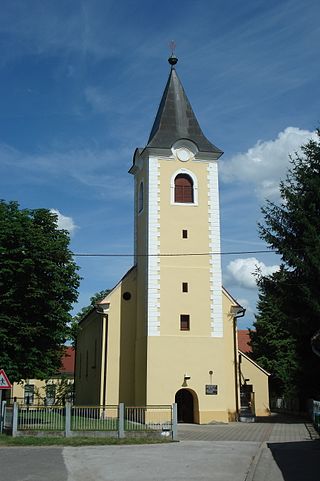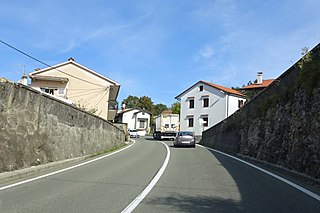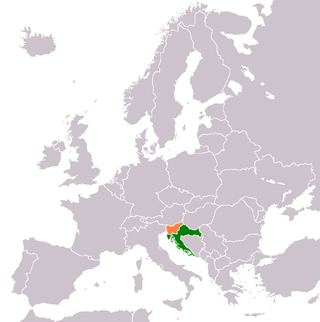
Istria is the largest peninsula within the Adriatic Sea. The peninsula is located at the head of the Adriatic between the Gulf of Trieste and the Kvarner Gulf. It is shared by three countries: Croatia, Slovenia, and Italy, with 90% of surface area being part of Croatia. Croatia encapsulates most of the Istrian peninsula within Istria County.

Opatija is a town and a municipality in Primorje-Gorski Kotar County in western Croatia. The traditional seaside resort on the Kvarner Gulf is known for its Mediterranean climate and its historic buildings reminiscent of the Austrian Riviera.

Gorizia (Italian pronunciation:[ɡoˈrittsja] ; Slovene: Gorica, colloquially stara Gorica 'old Gorizia' to distinguish it from Nova Gorica; Standard Friulian: Gurize, Southeastern Friulian: Guriza; Bisiacco: Gorisia; German: Görz ; is a town and comune in northeastern Italy, in the autonomous region of Friuli-Venezia Giulia. It is located at the foot of the Julian Alps, bordering Slovenia. It is the capital of the Regional decentralization entity of Gorizia and is a local center of tourism, industry, and commerce. Since 1947, a twin town of Nova Gorica has developed on the other side of the modern-day Italy–Slovenia border. The region was subject to territorial dispute between Italy and Yugoslavia after World War II: after the new boundaries were established in 1947 and the old town was left to Italy, Nova Gorica was built on the Yugoslav side. The two towns constitute a conurbation, which also includes the Slovenian municipality of Šempeter-Vrtojba. Since May 2011, these three towns have been joined in a common trans-border metropolitan zone, administered by a joint administration board.

Primorje – Gorski Kotar County is a county in western Croatia, most of it based in the historical and cultural region called Croatia proper and some of it in Istria, including the Bay of Kvarner, the surrounding Northern Croatian Littoral, and the mountainous region of Gorski Kotar. Its center is Rijeka. The county's population was 296,195 at the 2011 census.

Koper is the fifth largest city in Slovenia. Located in the Istrian region in the southwestern part of the country, approximately five kilometres south of the border with Italy and 20 kilometres from Trieste, Koper is the largest coastal city in the country. It is bordered by the satellite towns of Izola and Ankaran. With a unique ecology and biodiversity, it is considered an important natural resource. The city's Port of Koper is Slovenia's only container port and a major contributor to the economy of the Municipality of Koper. The influence of the Port of Koper on tourism was one of the factors in Ankaran deciding to leave the municipality in a referendum in 2011 to establish its own municipality. The city is a destination for a number of Mediterranean cruising lines. Koper is the main urban centre of the Slovenian Istria, with a population of about 25,000. Aleš Bržan is the current mayor, serving since 2018.

Brtonigla is a village and a municipality in the north-western part of Istria County, Croatia. Brtonigla is officially bilingual, with Croatian and Italian being equal; in 2011, 40% of the population declared themselves as ethnic Italians.

The most recent enlargement of the European Union saw Croatia become the European Union's 28th member state on 1 July 2013. The country applied for EU membership in 2003, and the European Commission recommended making it an official candidate in early 2004. Candidate country status was granted to Croatia by the European Council in mid-2004. The entry negotiations, while originally set for March 2005, began in October that year together with the screening process.

Matulji is a municipality in Primorje-Gorski Kotar County, Croatia. It is located 10 kilometers (6 mi) west of the city of Rijeka, north of the town of Opatija, and it borders Slovenia. Matulji is first mentioned in written historical sources in the middle of the 17th century, and it is preceded by the surname Matulja, which was originally recorded as Matuglia. As early as the beginning of the 19th century, official documents recorded the name of the settlement in its current form – Matulji.

The A7 motorway is a 42.4-kilometre-long (26.3 mi) motorway in Croatia. It connects the nation's largest port in Rijeka, to the Croatian motorway network, as well as to the Rupa and Pasjak border crossings to Slovenia. The motorway forms part of a longitudinal transportation corridor in Croatia, and it is a part of European route E61 Villach–Ljubljana–Trieste–Rijeka. The A7 motorway route south of Orehovica interchange, where it also intersects Pan-European corridor Vb, is a part of European route E65.

Gornji Mihaljevec is a village and municipality in Međimurje County, in northern Croatia.

Sveti Martin na Muri is a village and municipality in Međimurje County, in northern Croatia.

The Schengen Area is an area encompassing 27 European countries that have officially abolished border controls at their mutual borders. Being an element within the wider area of freedom, security and justice policy of the European Union (EU), it mostly functions as a single jurisdiction under a common visa policy for international travel purposes. The area is named after the 1985 Schengen Agreement and the 1990 Schengen Convention, both signed in Schengen, Luxembourg.

Plavje is a village in the City Municipality of Koper in the Littoral region of Slovenia. It is located on the northernmost edge of the Istrian peninsula, on the border with Italy, on a small hill overlooking the Gulf of Trieste.
Bregana is a settlement (naselje) that is part of the town of Samobor, Zagreb County, Croatia. According to the 2001 census, the town has 2,518 residents living in an area of 2.81 square kilometers (1.08 sq mi). Together with the nearby settlements of Podvrh and Klokočevec Samoborski, the town's micropolitan area has 3,450 inhabitants.
Obrežje is a settlement in the Municipality of Brežice in eastern Slovenia, close to the border with Croatia. The area is part of the traditional region of Lower Carniola. It is now included with the rest of the municipality in the Lower Sava Statistical Region.

Jelšane is a village in the Municipality of Ilirska Bistrica in the Inner Carniola region of Slovenia, right on the border with Croatia. The Jelšane international border crossing between Slovenia and Croatia is just south of the village. The Croatian settlement opposite Jelšane is Rupa in the municipality of Matulji. With Slovenia joining the Schengen area on December 21, 2007, Rupa-Jelšane became a Schengen external border crossing.

Adriatic–Ionian motorway or Trieste-Kalamata Highway or the Blue Corridor, is a future motorway that will stretch along the entire eastern shore of the Adriatic and Ionian seas, spanning the western coast of the Balkan peninsula from Italy in the north through Slovenia, Croatia, Montenegro, Albania to Greece in the south.

Pasjak is a village in Croatia, located on the border with Slovenia. Just north of the village is the northern endpoint of the D8 highway, at the eponymous Pasjak border crossing. The village is part of the Matulji municipality, in Primorje-Gorski Kotar County.

The Slovenian border barrier was a border barrier constructed by Slovenia in 2015–2016 on its border with Croatia as a response to the European migrant crisis. Both Slovenia and Croatia are European Union members, therefore the barrier was located on an internal EU border; but previously only Slovenia was a member of the free travel Schengen Area, with Croatia joining the area in 2023. In March 2016, Slovenia announced that only migrants who apply for asylum in Slovenia and those with clear humanitarian needs will be allowed to enter Slovenian territory.

The Memorial Centre Lipa Remembers is a museum commemorating the killing of 269 civilians - mostly elderly, women and children - in April 1944 in Lipa, Croatia. The massacre was perpetrated by the German military, together with Italian and Chetnik collaborationist forces.


















